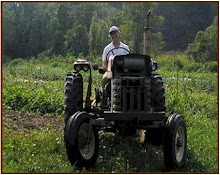FEATURED VEGGIES
Micro Mix (a mix of sunflower, buckwheat, radish, cabbage and kogane (pac choi)).
Salad Mix (I’m so glad to see this back in your shares! The greens have recovered and now you can get back to all that salad eating you’ve been missingJ.)
Green Bell Peppers (These beauties are doing great this year! If you can't enjoy them right away, think about slicing or chopping them, placing them in a Ziploc and storing them in your freezer for later.)
Mushrooms (You all know these oyster or shiitake mushrooms well by now and are hopefully enjoying them. Don’t forget that you can dry them for later use in soups, etc. by baking them on a cookie sheet at the lowest temperature and checking them until they are dry.)
Slicer Tomatoes (Ah, the round red tomato that we all know so well. Great for everything a tomato is great for, including canning. Unfortunately, these taste so good that they never last that long in my kitchen!)
Cherry Tomatoes (You all know our Sun Golds and Super Sweet 100s well by now.)
Green Beans (Crunchy wonderful green beans, what can I say about these? If you want to freeze these beauties, don’t forget to blanch them first and allow to cool before placing in a freezer bag—they don’t freeze too well if you don’t cook them just a little first.)
Beets (Sweet & tasty—I hope that you enjoy every bite. For easy peeling, just boil whole root, minus the leaves, for about 10 minutes, drain, rinse and rub the peel right off.)
ATHENS HILLS SUMMER CSA:
WEEK TEN
Hello Everyone!
Here we are at the mid-way point of this season. With a garden of my own exploding with summer’s bounty, as well as having access to the wonderful veggies at Green Edge, this means that it's time for me to get a move on, and start preserving these tasty treats for the future seasons. I’m sure many of you would like to do the same so I’ve focused this newsletter on veggie preservation. In the past I’ve included some recipes for canning various things, but this week I wanted to include some info. about other methods such as drying & freezing some of the goodies in your share. I hope these suggestions are helpful. If you have some of your own to share, please feel free to add your advice on our blog this week.
I just want to thank all of you for your efforts in getting our boxes back to us. Please keep up the good work; we really appreciate it! Also, please feel free to contact us with any of your comments, suggestions, critiques, recipes, etc., during this second half of the season. These are also greatly appreciated.
Have a great week and keep your eyes out for our Winter 2009 CSA brochure which will appear online in a couple of weeks. Sign-up is on a first come, first served basis and we will be taking memberships as soon as the brochure is available. Thanks for your support!
Best Wishes,
Claudia
Storing & Ripening Tomatoes
NEVER REFRIGERATE FRESH TOMATOES! Cold temperatures make the flesh of a tomato pulpy and destroy the flavor.
To ripen, place green or unripened tomatoes in a brown paper bag and place in a dark spot for three or four days, depending on the degree of greenness. Do not put tomatoes in the sun to ripen - this softens them.
Freezing Tomatoes
The simplest way to preserve tomatoes is to freeze them whole. Just rinse them, spread them out on a cookie sheet, and freeze overnight. When frozen, put them in a freezer bag and return to the freezer. To use, remove from bag and thaw. When thawed, slip the skins off, and use in your favorite recipes.
Peel the tomatoes, puree them in a blender, and then strain them through cheesecloth or a coffee filer to drain off the excess tomato water (this can be used in soups). Freeze the pulp in ice cube trays. When frozen, store the frozen cubes in a freezer bag.
(Advice and recipes courtesy of www.whatscookingamerica.net/tomatoes, August 2008.)
Recipe: Preserving Mushrooms
1.) Blanching and Freezing - This remains my most versatile method of preserving large quantities of mushrooms, especially those requiring rapid or delicate handling, such as Coprinus comatus (shaggy mane). Also, washing in water does not hurt the end product, so mushrooms noted for trapping sand and dirt can be thoroughly washed first.
Method - Washed Mushrooms are taken directly from a cold water wash basin or sink where they have been cleaned, washed and are still soaking in the tub of water with a colander or sieve, drained for a moment and plunged directly into a pot of boiling water for 1 to 2 minutes after water re-boils. They are then removed with a sieve or colander and are plunged into cold water to stop the cooking process. Once cool, the mushrooms are drained and placed in plastic freezer containers. A mass-production line can be set up; blanched product into cold water, while cooling, new raw product into hot blanch liquid, etc. The process becomes very efficient. At the end, I cool the blanching water and place into the containers of mushrooms, leaving enough headspace so freezing won't overfill or rupture the containers (usually 1 to 11/2 inches is fine for most freezer container shapes, I especially prefer small 8oz. yogurt containers; they are a perfect size to drop into a pot of soup (1/2 to 3/4 inch headspace is OK for these). .
Uses - I use these frozen mushrooms in soups and stews throughout the non-collecting months by simply dropping the entire frozen contents into soup 20 minutes to 1/2 hour prior to the soup completion time, letting it simmer the last 20 to 30 minutes and AH! Perfection! It makes especially good beef barley soup with Shaggy manes.
desirable. Flavor preservation is exceptional.
Disadvantages - Not as high quality product for uses requiring frying, sautéing, or crisping of mushrooms, but actually can still be done.
2.) Drying - The age-old method of drying mushrooms is still one of the best methods of preserving mushrooms. Boletes edulis are seen all over Italy, dried and wrapped in often elaborate (and expensive) displays. Methods vary from good old sun/air drying to machine drying (dehydrators) or to oven drying. Different methods give somewhat different results, but is mostly a question of how elaborate and how much you willing to invest to accomplish this. Many good home-use dehydrators are on the market. Units with temperature control, such as top-of-the-line American Harvester, are particularly versatile, especially in humid areas or during spells of rain.
Method - Slice/prepare mushrooms, set on drying trays or racks and sun dry (protect from insects and flies) or pleasing dehydrator or oven (very low temperatures 100 degrees Fahrenheit to 150 degrees Fahrenheit). Dry to low moisture level, place in airtight bags or jars and store. To reconstitute, cover with warm or hot water 15 minutes to several hours (varies with species) until plumped up. Do not use only the water from the tap for your recipes; be sure to use the soak water from the mushrooms as it is richly flavored. Save it for other later uses if the recipe does not call for liquid. Freeze it if no
immediate use is at hand. It's worth it. David Aurora mentions that the pore-masses from Boletes can be dried separately from the mushrooms, soaked to reconstitute not for the pore masses as they are slimy, but for the soak liquid reserved after wringing out the masses for uses in gravies, soups, etc. It is truly a wonderful use of something otherwise usually discarded.
Advantages - Drying preserves mushrooms for very long periods of time with little or no deterioration in flavor or quality. Drying actually intensifies the mushrooms flavor of many species, especially the Boletes - convenient easy to store and use, requiring no special equipment or refrigeration.
Disadvantages - Drying often toughens or changes mushrooms texture; many will not fry or sauté after being dried. Sometimes flavor changes character after drying occurs. Volatile flavors and aromas are often lost. Reconstituting does not necessarily restore good texture in many cases. Equipment can be elaborate and expensive.
(Advice and recipes courtesy of www.nmmastergardeners.org/Fungi, August 2008.)
Have a wonderful week and don’t forget you can contact us at:
(740) 448-4021
greenedgegardens@verizon.net
Or visit us at our blog…
www.greenedgegardens.blogspot.com













































































































































































